-
1903Pair of Fern Spray brooches
Cartier Paris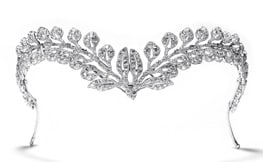 These fully articulated, supple brooches could originally be worn as a tiara on a rigid band. In 1904, the client commissioned a mount to allow the brooches to be worn as a necklace or bodice ornament with the fronds facing outwards.
These fully articulated, supple brooches could originally be worn as a tiara on a rigid band. In 1904, the client commissioned a mount to allow the brooches to be worn as a necklace or bodice ornament with the fronds facing outwards.
The transformable pieces were supplied in a case with a small screwdriver. Sold to Sir Ernest Cassel. Sir Ernest Cassel (1852-1921) was a friend and private financial advisor to Edward VII. In 1922 his granddaughter, the Honourable Edwina Ashley, married the last Viceroy of India, Lord Louis Mountbatten (later Earl Mountbatten of Burma). -
1907Japanese Bow brooch
Cartier Paris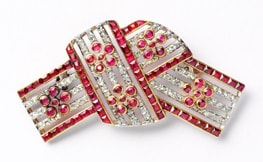 Platinum, gold, rose-cut diamonds, faceted and calibrated round rubies. An original interpretation of the Japonist influence that proliferated in Europe from the late 19th century.
Platinum, gold, rose-cut diamonds, faceted and calibrated round rubies. An original interpretation of the Japonist influence that proliferated in Europe from the late 19th century.
Cartier Collection
Vincent Wulveryck, Cartier Collection © Cartier -
1907Brooch
Cartier Paris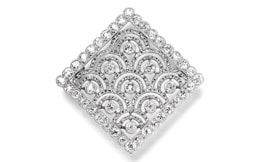 Platinum, old-cut and rose-cut round diamonds, millegrain set
Platinum, old-cut and rose-cut round diamonds, millegrain set
Nick Welsh, Cartier Collection © Cartier -
1925Japanese Apple Tree
Cartier Paris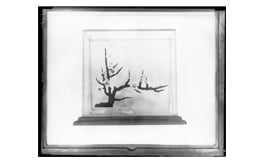 Produced in ivory, milky agate, moonstones and pâte d’émail.
Produced in ivory, milky agate, moonstones and pâte d’émail.
This piece is now held in the Cartier Collection. -
1927Japanese Tree vanity case
Cartier Paris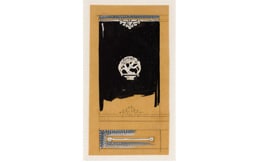 Produced in gold, enamel, rock crystal and diamonds, graphite pencil, Indian ink and gouache on tracing paper.
Produced in gold, enamel, rock crystal and diamonds, graphite pencil, Indian ink and gouache on tracing paper.
Cartier Collection -
1928Japanese Tree powder case
Cartier Paris Produced in gold, enamel and diamonds.
Produced in gold, enamel and diamonds. -
1930Vanity case
Cartier Paris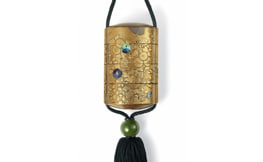 The interior is divided into two equal sections: a cigarette compartment with a tortoiseshell-backed mirror as a lid, and two lidded powder boxes.
The interior is divided into two equal sections: a cigarette compartment with a tortoiseshell-backed mirror as a lid, and two lidded powder boxes.
The case described as an ‘18th century lacquer’ was supplied by the client, and is an antique Japanese inrô. The stack of nested compartments that make up the inrô is held together by a cord secured by an ojime or bead that holds the case in place. A netsuke or charm at the top attaches the cord to the sash.
The inrô or compartmentalised case suspended from the waist was originally designed for carrying medicine. By the 19th century it had become a status symbol. Inrô cases were now carefully crafted from the finest materials, and the lacquer finish complemented by the inclusion of ivory, mother-of-pearl, gold and silver.
Cartier Collection -
1942Charm bracelet
Cartier New York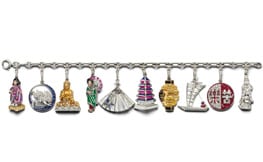 Bracelet composed of 10 Japanese-inspired charms: girl doll on stand; crescent moon medal depicting hare and wave; Buddha or bodhisattva; lady holding parasol; fan; pagoda; lantern; junk ship; medal depicting two ideograms; priest.
Bracelet composed of 10 Japanese-inspired charms: girl doll on stand; crescent moon medal depicting hare and wave; Buddha or bodhisattva; lady holding parasol; fan; pagoda; lantern; junk ship; medal depicting two ideograms; priest.
Length: 18 cm. Height of charms approx. 2.80 cm (including suspension loop).
Cartier Collection -
2016Cartier Ginza boutique
 In Ginza, the base has all the grandeur of the building it supports. In contrast, the upper stories feature a more abstract design that covers the whole of the building and adds the effect of perspective. This motif is made up of rectangular slits suggestive of Shoji (Japanese screens) and traditional paper and wood cuts. From the street, the arrangement of slits is reminiscent of the Japanese cedar (Sugi), Japan’s national tree which symbolises serenity.
In Ginza, the base has all the grandeur of the building it supports. In contrast, the upper stories feature a more abstract design that covers the whole of the building and adds the effect of perspective. This motif is made up of rectangular slits suggestive of Shoji (Japanese screens) and traditional paper and wood cuts. From the street, the arrangement of slits is reminiscent of the Japanese cedar (Sugi), Japan’s national tree which symbolises serenity.
